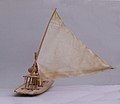Jangada
Jangadas are seaworthy sail rafts that are used for fishing on the coast of northeast Brazil , especially in the state of Ceará .
history
In the 15th century, the Portuguese met locals in northeastern Brazil who used narrow rafts to fish the rivers and lagoons. The Portuguese had seen similar rafts in India . The Portuguese named the Brazilian rafts Jangadas based on these vehicles, which are called Jangas . When fish and crabs became scarce near the coast, the design of the rafts had to be adapted. They were given sails and swords and were put together with wooden nails instead of ropes.
The float
Until around 1990, the "Jangada de Pau do Pará" made of logs or bars was still in general use - made from balsa wood, which comes from the state of Pará.
In its original form, the Jangada consists of six 5 - 7 m long light wood bars that are hewn with an ax in such a way that they can be joined together to form a slightly curved platform that tapers slightly from back to front. The middle ( meios ) and the adjacent ( mimburas ) planks are most strongly developed, the outer ( bordos ), which form the end, are slimmer and lighter. They are connected by ropes and hardwood wedges that swell in the water and hold as good as screws. According to tradition, no metal screws were allowed to be used in the construction of a jangada, otherwise the vehicle was intended to sink.
Baskets and nets, which are hung from a post on the rear section of the raft, are used to store food, fishing gear and booty. Immediately afterwards there is also a second frame as a kind of table and support for resting.
In the front third and in the middle there is a mast base and a bracket with a hole that hold the removable mast . A bracket is mounted on the rear third, to which all the raft's equipment, such as ropes, paddles, anchors, fish baskets and personal utensils of the fishermen, are firmly moored. On the stern is the firmly embedded bench of the helmsman who is also the Jangada captain.
The sails and controls
The triangular curved sail is firmly connected to the mast by lacing on its foreleck and can be rolled up and removed together with the mast. The comparatively long foot is attached to a loop on the clew with a tree. The tree has a fork with which it is supported against the mast above the trestle.
The mast, which is slightly curved at the top, is rarely vertical, depending on the course and the wind , it is inserted into various holes in the base of the mast, thus keeping the sail in the most favorable position to the wind. The direction of travel is determined with the sail position.
In the gap left at the stern between the middle trunk and the two adjacent trunks, wide paddles are inserted, which have the function of keel swords and reduce lateral drift.
More modern construction
Nowadays, the traditional “Jangada de Pau” has been replaced almost everywhere by the more modern and, above all, more durable “Jangada de Tábua” (the “Brett-Jangada”): Instead of using trunks, the hulls are made with planed planks and as a dense hollow body with about the the same dimensions as the trunk rafts. This offers the advantage that the captured fish can be stored better protected inside the hollow body. Even this rather boat-like buoyancy body is washed over by higher waves during the journey.
The team
The earlier "Jangadeiros" stood barefoot on the trunks and protected themselves against wind, salt water and the burning sun with typical brown-red jackets and trousers as well as wide-brimmed white hats. The three to five-man crew fished with hand lines and hooks. At night they tied themselves to the mast so as not to be washed overboard by a wave.
The Jangada captain, the mestre de Jangada , steers the raft with a huge stern rudder and determines where to stop at sea because he has the most experience of where the schools of fish are. The proeiro is the one in a team of three in a Jangada who knows how to handle the mast and sails best, and the bico de proa is his assistant, who helps him with all the ancillary work.
With these rafts, the Jangadeiros venture out to sea up to 120 kilometers from the coast, where they harpoon sharks and sea turtles and fish for fish.
Individual evidence
- ↑ Neil Hollander, Harald Mertes: As long as they are still sailing. The last work sailors. Hamburg 1983, p. 50




